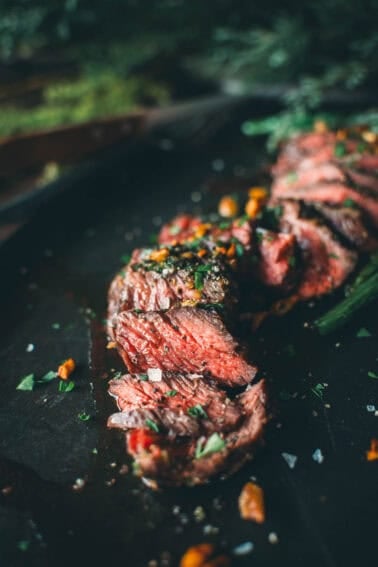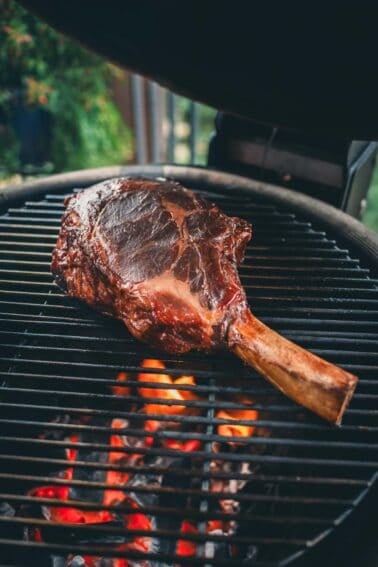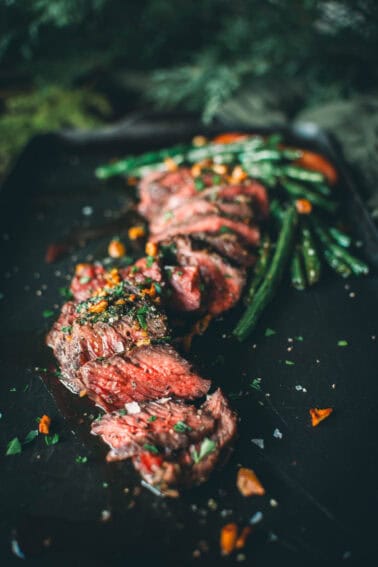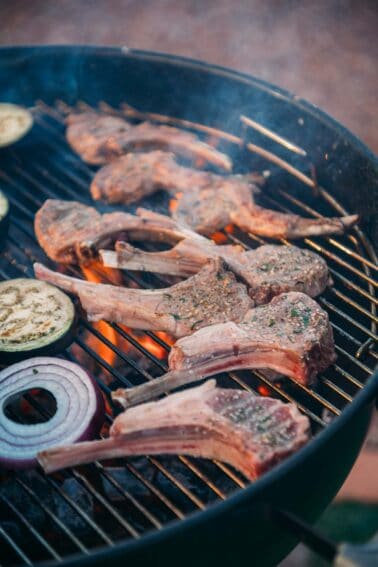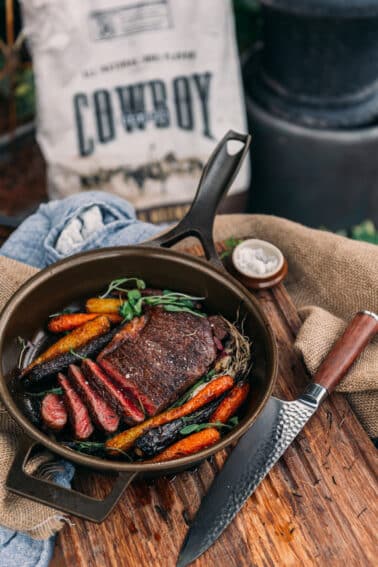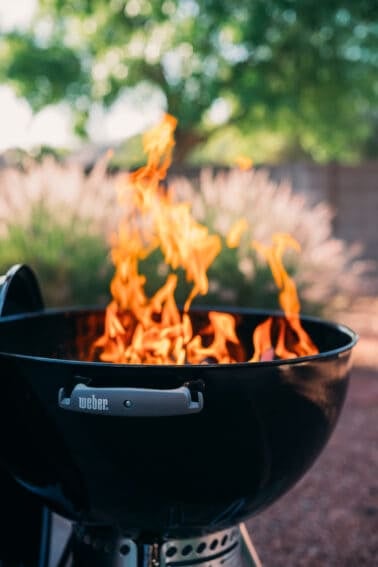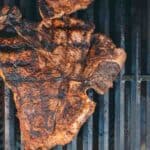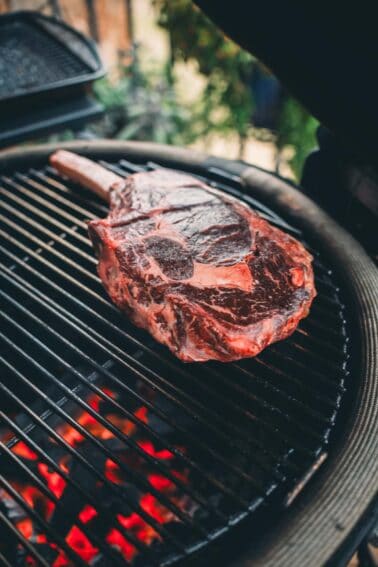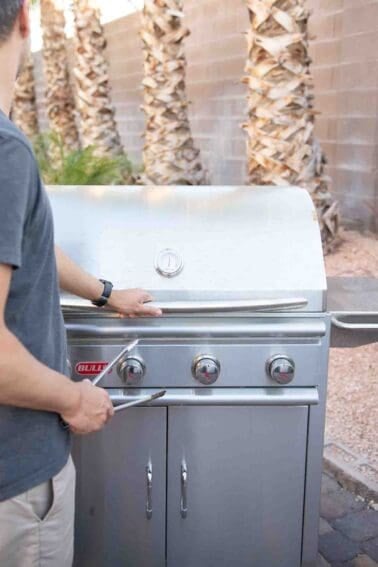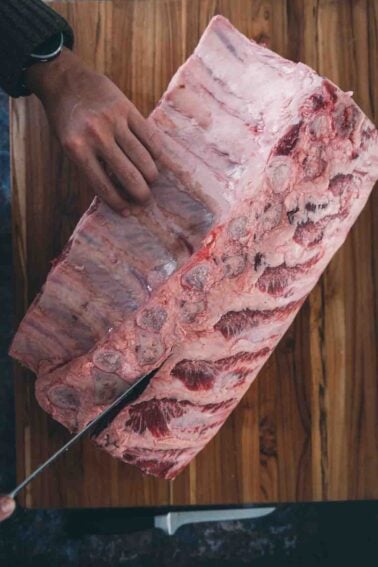There’s nothing quite like the sizzle of a juicy steak on a hot grill. Grilling steaks on a gas grill is a fantastic way to bring out the natural flavors and achieve that coveted caramelized crust. Whether you’re a seasoned grilling pro or a beginner, our guide will equip you with the knowledge and techniques to create restaurant-quality steaks in the comfort of your own backyard.
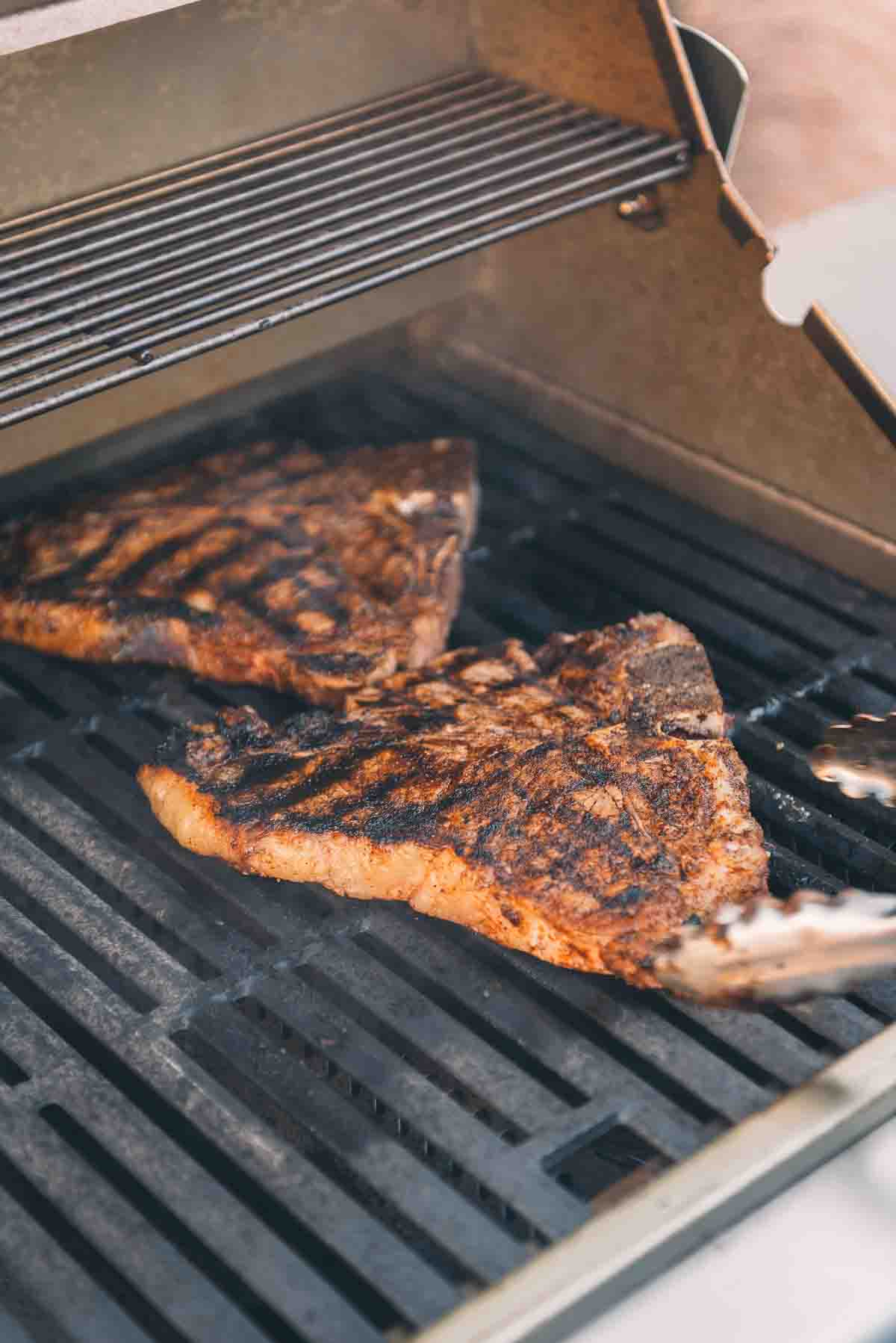
Table of Contents
- Quick tips for how to grill a steak on a gas grill
- Choosing the Right Steak
- Preparing the Grill
- Seasoning and Preparing the Steak
- How to Grill a Steak: Techniques
- How to Grill Steak on Gas Grill: Timing and Doneness Level
- Steak on the Grill: Resting and Slicing
- How to Grill a Steak on a Gas Grill: Step by Step Guide
- Our favorite Grilled Steak Recipes
- Serving and Pairing
- More helpful grilling guides
- How To Grill A Steak Recipe
- FAQs
- More Favorites from Girl Carnivore:
What’s so great about grilling steak on a gas grill? So much! The beautiful grill marks left when the meat is finished, the delicious flavor on your masterfully cooked steak recipe, the tender cut, and the simplicity!
Gas grills are such versatile tools, and they’re extremely convenient for all your grilling recipes. Cooking with them makes it easy to control the heat as needed, and it doesn’t take rocket science to use them. When aiming for convenience and ease, it’s one of the best ways to cook a steak. To learn how to grill steaks on a gas grill, continue reading! We’ll lay out all the tips and tricks to help you be successful.
Quick tips for how to grill a steak on a gas grill
- Choose the right steak for gas grilling, such as ribeye or strip steak with Choice/Prime grade.
- Prep your steak by allowing it to come to room temperature and seasoning or marinating before cooking if needed.
- Grill using two zones of heat & monitor internal temperature for perfect results. Serve after resting for 5 minutes.
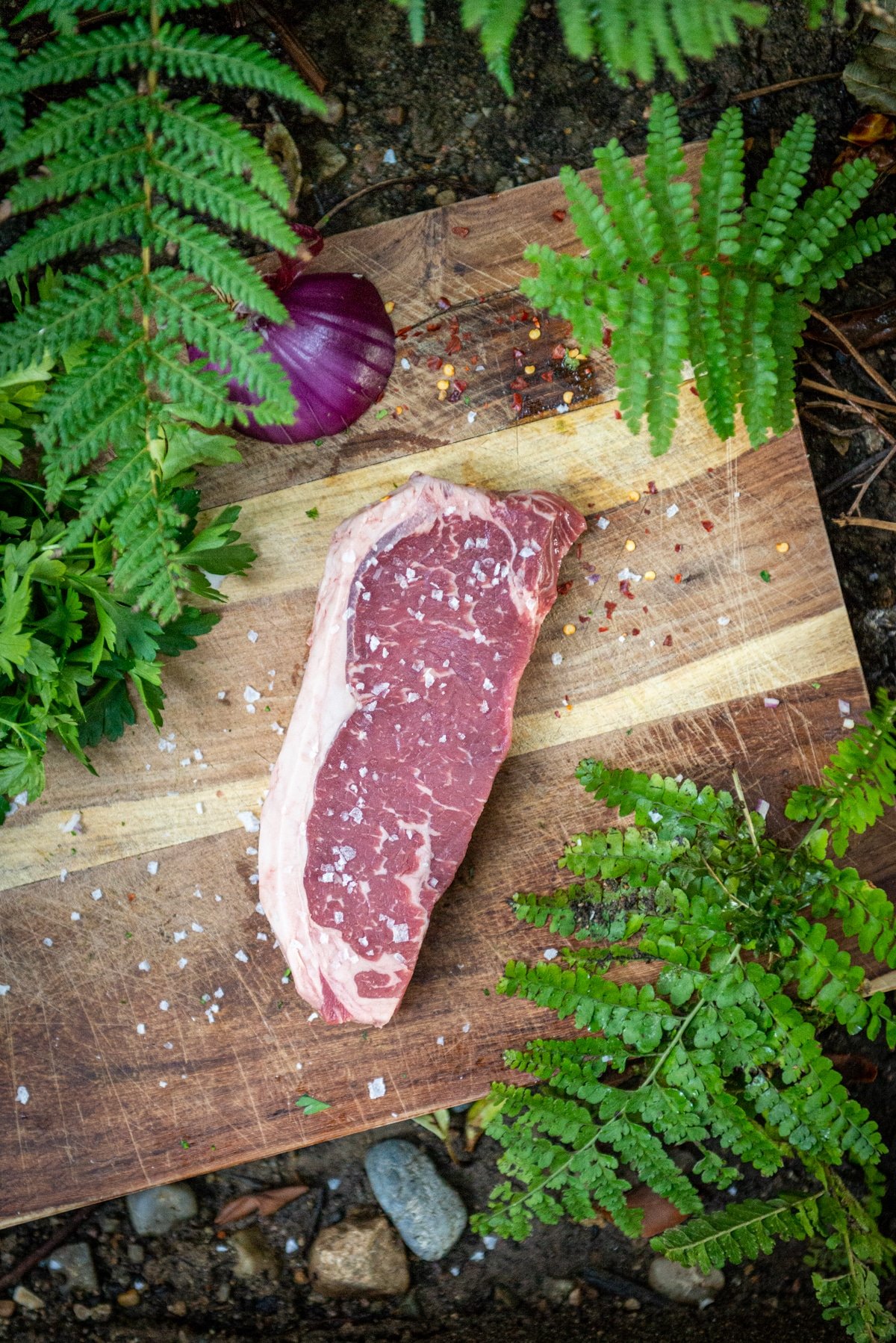
Choosing the Right Steak
Choosing your cut of meat to grill is just half the fun. Here are some of the best steaks for grilling you’ll enjoy for dinner.
- Chuck Eye Steak – Use this inexpensive cut of meat to make your grilling experience enjoyable.
- Ranch Steak – If you are grilling or broiling, this cut is perfect. It’s lean and versatile with great flavor.
- Flat Iron Steak – This piece of meat is cut from the top blade of the cow and is very tender once cooked.
- Tenderloin Steak – The leanest of all the steaks with a buttery texture, also known as filet mignon. Did you know you can save tons of money by trimming a whole beef tenderloin?
- Strip Steaks – A tender and leaner cut of meat perfect for grilling.
- Porterhouse Steak – Need a steak for two? This cut is your best option and can be seasoned beautifully in so many ways.
- T-Bone Steak – This steak is smaller than the porterhouse but still packs a punch when it comes to taste.
- Kabobs – Want to make a grilling experience with vegetables? Add a kabob cut of meat to the skewer.
- Flank Steak – This is a great steak for marinating and adding to stir fry. It has a bold beef flavor.
- Skirt Steak – Choose this cut of meat If you are making fajitas because it has a great robust flavor.
- Ribeye Steak – This beautifully marbled steak provides great flavor with a tender bite. Go for good marbling for a tasty flavor.
Each of the above is a good candidate for a great night of grilling. See our tested places for the best places to order meat online if you want to splurge for a nice cut. Choose your best seasoning and enjoy your flavorful steaks.
Preparing the Grill
Just like with how to set up your charcoal grill, prepping your gas grill for cooking is an important step.
Cleaning the grill ensures that no leftover food is on the grates. It’s like grilling on a new appliance every time. Oiling your grill grates helps keep things looking shiny and new and helps food from sticking the next time you go to cook a piece of meat. This is important so you don’t have leftover food on the grill grates between cooking sessions. It also makes for a better flavor profile when you start with a clean slate, er grate.
- Preheat the grill: Preheat your grill on high heat for about 10-15 minutes. This will help loosen any food residue on the grates.
- Clean the grates: Use a grill brush to scrub the grates thoroughly, removing any stuck-on food particles or debris. Make sure to clean both sides of the grates.
- Oil the grates: Once the grates are clean, lightly coat them with a high-heat oil like vegetable oil or canola oil. Use a brush or a folded paper towel soaked in oil to apply a thin layer.
- Heat the grill again: Close the lid and heat the grill for a few more minutes to allow the oil to heat up and create a non-stick surface on the grates, just like seasoning a cast iron skillet.
Preheating the grill prevents your food from sticking to the grill grates and makes it easier to flip your steaks without pulling or tearing the meat. This is important even if you’re learning how to grill a steak on a charcaol grill. Get to know your grill temperature and how long it takes to preheat. The key to perfect grill marks is a preheated grill and hot grill grates!
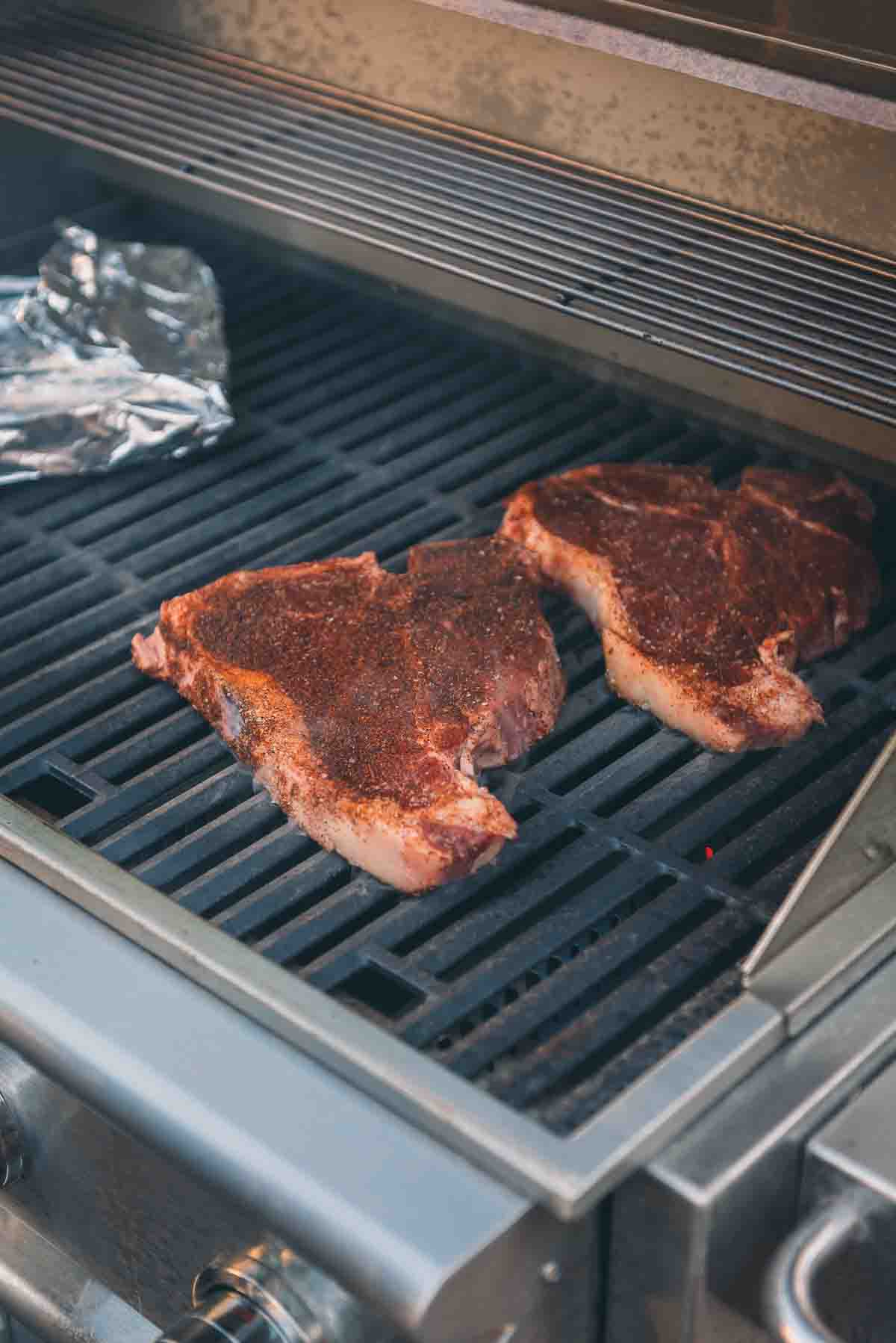
Seasoning and Preparing the Steak
When it comes to prepping a steak for grilling, we believe in keeping it simple. Whether it’s a reverse seared cowboy ribeye or a hot and fast grilled t-bone, we love to let the flavor of the beef shine through. However, some steaks need a little help to tenderize and add flavor, and we start those with a classic steak marinade.
To marinate or not
Popular marinades or seasonings for steaks include soy sauce, lemon juice, olive oil, minced garlic, Italian seasoning, salt and pepper, Worcestershire sauce, basil, and parsley. Get creative with your steak seasonings, and play around with different types of steak. We add herbs to our all-purpose marinade or citrus to our flank steak marinade when getting ready to grill, depending on the menu.
- Steaks to marinate: Steaks we love to marinate include flank steak, skirt, sierra, or other lean steaks that come from working parts of the cow. These tough cuts need an added depth of flavor or tenderizing to help them remain tender and juicy when you slice into them.
- Steaks not to marinate: Steaks that are already tender, such as tenderloin filets, don’t need a marinade. A marinade can make cuts like this soft. They let their flavor speak for themselves. Steaks with good flavor and marbling, such as the ribeye, also don’t need a marinade. They let the flavor speak for themselves.
Season with salt
When it comes to seasoning meat, salt plays a crucial role in enhancing its flavor. Even a small amount of salt can bring out the best flavor profile in the meat. One of the reasons we salt steaks ahead of time is because it helps draw out excess moisture from the meat, allowing it to develop a fantastic crust when cooked on the grill or in a cast iron pan.
To achieve this, generously coat all sides of the steak with salt and let it rest for 4 to 8 hours before cooking. This technique allows the flavors to penetrate the meat, resulting in a more delicious and well-seasoned steak.
Once the steak is grilled to perfection, take it to the next level by letting it rest with a dollop of herbed compound butter. This adds a touch of umami flavor that complements the steak beautifully, giving it an irresistible taste sensation.
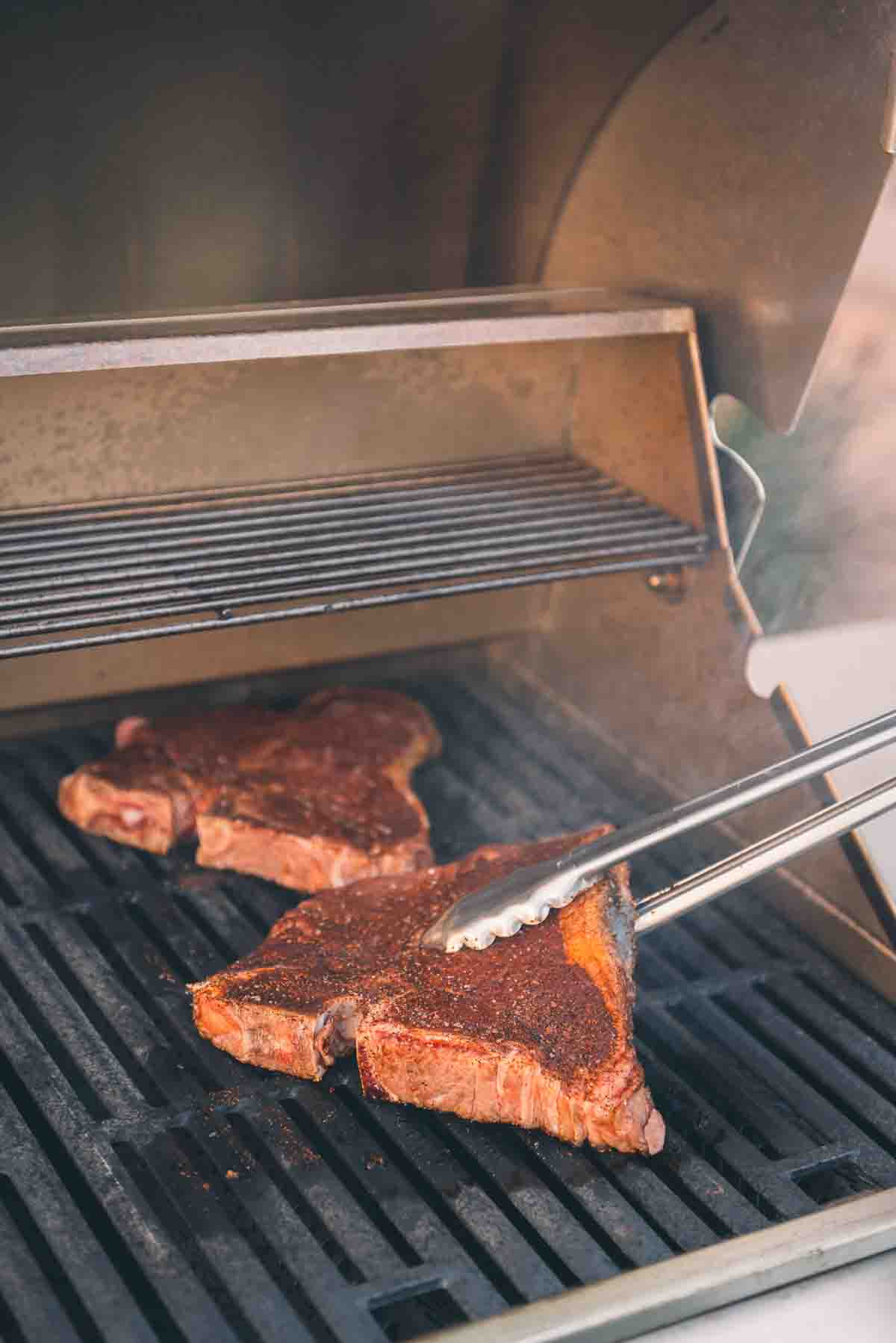
How to Grill a Steak: Techniques
Creating two heat zones on your gas grill is essential for perfectly grilled steak. One burner should be very hot for searing the steak, while another should be turned down to medium for finishing the steak and cooking it through. This setup allows you to control the cooking process and achieve the desired level of doneness without overcooking your steak.
Cooking your meat over direct or indirect heat depends on the cut of the meat. If you have a cut that requires quick cook, you’ll want to put it over direct heat. If you need your meat to cook over a longer period of time, place it adjacent to the heat for an indirect cook. This is also great for reverse searing or smoking with wood chips on a gas grill.
Hot and fast vs. low and slow
- Thin cuts, like the t-bone, New York strip steak, or hanger steak, can cook hot and fast over direct heat to a beautiful medium rare.
- Thicker steaks, usually 1 1/2 inches or bigger, like the thick-cut bone-in ribeye, tomahawk steak, or porterhouse steaks, are perfect for cooking over indirect heat with the reverse sear technique.
When searing a steak, the outer layer of the meat becomes beautifully crispy, creating a mouthwatering crust and sealing in the natural juices. This transformative process is known as the Maillard reaction, a chemical reaction that occurs when proteins and sugars in food are exposed to high heat., resulting in a rich brown color and enhanced flavor.
For thicker steaks that need to cook longer on the cooler side of the grill, consider reverse searing: slow-cook the steak over low heat on the cool side of the grill, and finish with a high-heat sear. The result is a delectable combination of a perfectly crisp crust and a tender, juicy interior, delivering an irresistible texture that will delight any steak enthusiast.
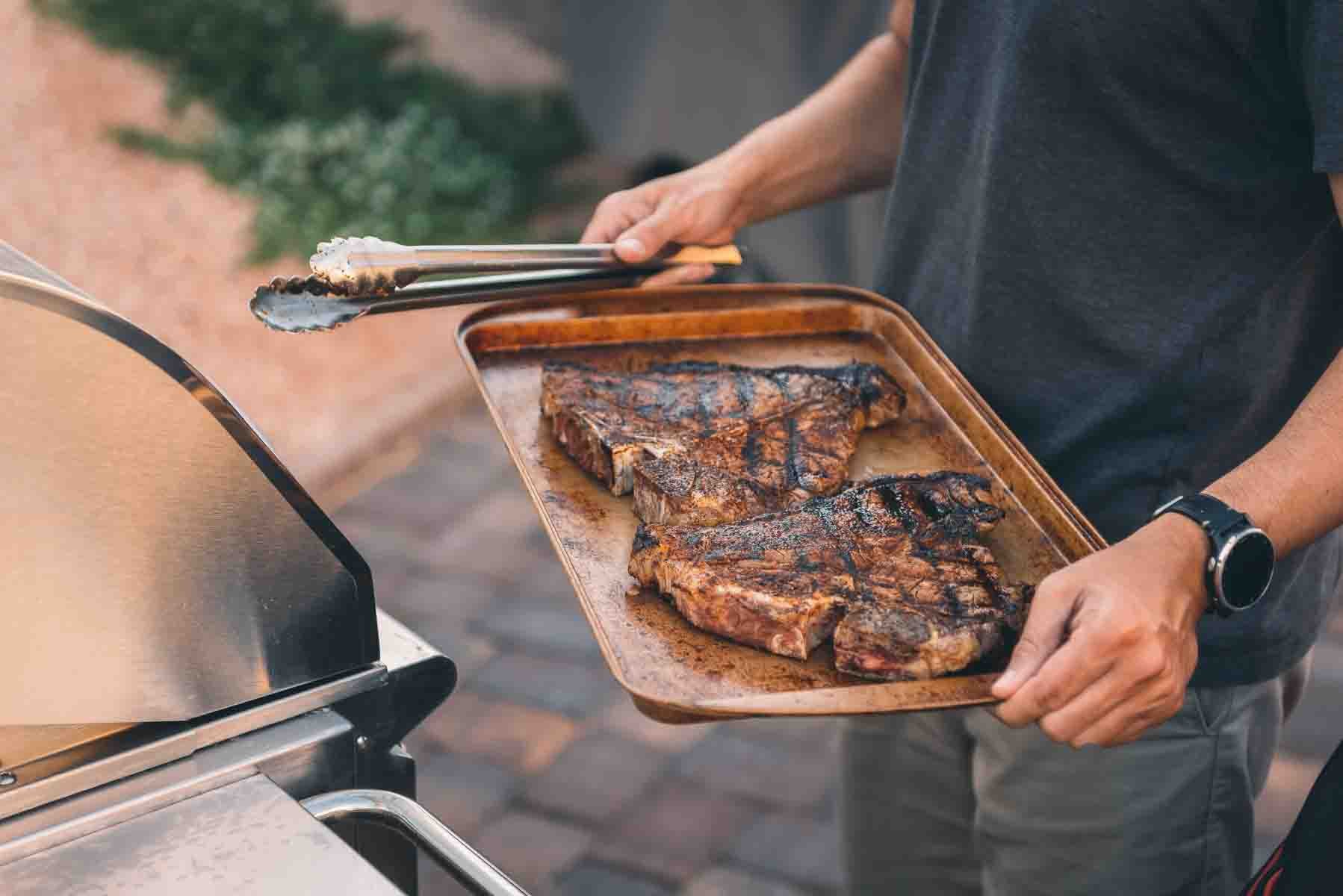
How to Grill Steak on Gas Grill: Timing and Doneness Level
How do you determine if your steak is done? Use an instant-read thermometer for the most accurate results. Steak doneness times depend on the thickness of the steak, the heat of the grill, and other factors. A good rule of thumb for a 1-inch steak is to cook for 3 to 5 minutes per side, depending on your desired level of doneness.
We stick with our 2+2+2 rule for 1-inch cuts like ribeyes and sirloin filets. We sear for two minutes, rotate 90 degrees, sear for another 2, flip, and finish cooking for two.
Generally, we like our steaks medium-rare to medium, so this usually gets the job done. If you like you’re steaks more well done, add time; however, keep in mind as the fat renders, it can drip into the grates and cause flare-ups. Always keep long tongs on hand to maneuver the steak to the cooler side of the grill if needed.
You can check out our steak doneness guide to determine whether your meat is cooked thoroughly.
| RARE 120 °F | MEDIUM RARE 130 °F | MEDIUM 135 °F |
| MEDIUM WELL 145 °F | WELL DONE 155 °F | LEATHER 160 °F + |

Steak on the Grill: Resting and Slicing
Don’t just cut into your steak immediately after you’re done grilling. Let that prime piece of meat rest for at least 7 to 10 minutes. If you cut right into the steak, all of the delicious juices will flow right out. By letting the steak rest, you allow the juices to distribute throughout the steak before you take that first bite.
With any steak cut, you should cut against the grain. Use a sharp knife to cut across the muscle fibers so you have the perfect bite with each cut. Letting the steak rest and slicing it against the grain is the best way to get the most tender, juicy bite from your masterfully grilled steak.
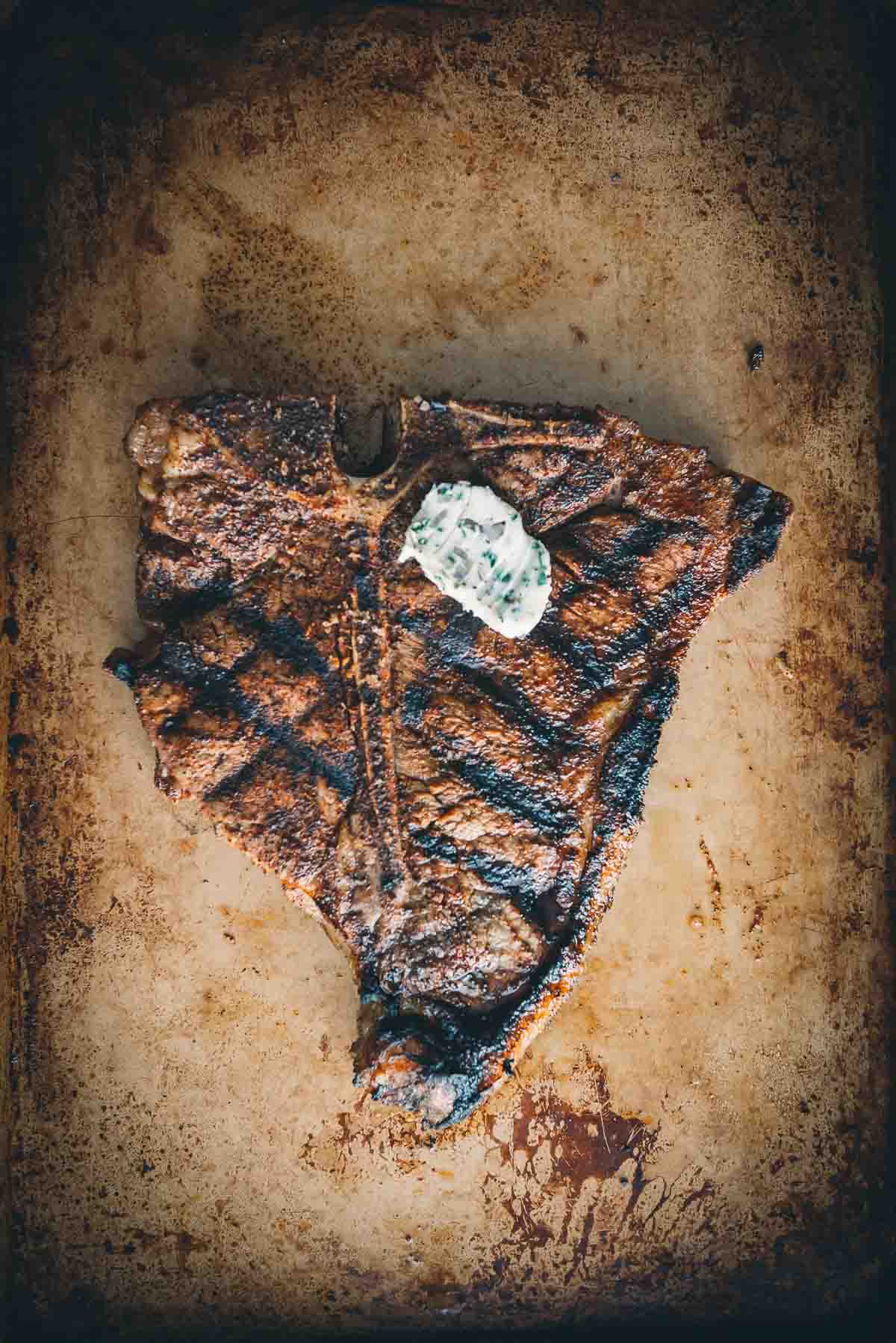
How to Grill a Steak on a Gas Grill: Step by Step Guide
Once you get the hang of grilling steaks, it’s simple. Here’s an easy guide to get you started!
- Before you grill your steaks, let them reach room temperature. This takes about 20 minutes, depending on the thickness of the steak.
- In the meantime, heat your grill to the highest temperature.
- Season with salt on both sides.
- Sear the sides of the steaks for about 2 minutes before completing the cooking process.
- Rotate and cook for another 2 minutes before flipping and completing the cooking process to get those desired grill marks. Depending on the thickness of the steak, you may need to let the steak continue to cook on the cool side of the grill. Thick cuts of meat will need more cooking time to reach doneness. If you want a medium-rare steak, you won’t have to cook it quite as long as a well-done steak.
- Remove steaks from the grill with tongs and let them rest with a dollop of compound butter tented with foil for a few minutes before serving.
- When ready to serve, slice the perfect grilled steak into strips against the grain and serve it with your favorite side dishes.
Our favorite Grilled Steak Recipes
Beef Recipes
Garlic Butter Basted Grilled Teres Major Steak
Beef Recipes
Grilled Cowboy Steak
Beef Recipes
Grilled Denver Steak with Herb Butter
Serving and Pairing
Steaks are an amazing meal centerpiece, but they aren’t complete without tasty sides. Campfire potatoes or Umami Smoked Mushrooms help fill up your belly and add flavor to your tastebuds. Try a Smoked Potato or some Jalapeno Popper Fries for a little fun.
If you love a good drink, pair your steaks with red wine, like Pinot Noir or Cab. Or say cheers with a tasty smoked old fashioned. You also can’t go wrong with a vanilla sea breeze cocktail in the summertime.

With various meat options and grilling techniques, there are endless possibilities to explore as you become an expert at grilling steaks on a gas grill. As you embark on your grilling adventure, consider the type of meat you’re using and the flavor profile you want to achieve. Take the time to research and experiment with different marinades and seasonings that complement your chosen meat by checking out our full recipe archives and helpful guides.
Grilling is an incredibly versatile activity that offers a wide range of options and possibilities. Whether you’re cooking steaks, burgers, chicken, seafood, or even vegetables, grilling allows you to explore different flavors, textures, and cooking techniques. With the ability to adjust heat levels and experiment with marinades, seasonings, and smoking techniques, grilling offers endless opportunities to create delicious and unique dishes.
Once you have your desired meat, it’s crucial to properly prepare your grill. Ensure it is clean and ready for cooking, and remember to check the doneness of your meat using a meat thermometer. After grilling, make sure to clean your grill thoroughly to avoid any leftover food residue that may affect future cooking sessions. By taking care of your gas grill, it will continue to provide you with great grilling experiences for years to come!
More helpful grilling guides
For more delicious recipes and summer grilling guides, check these out.
Have you tried this recipe? Do us a favor and rate the recipe card with the ⭐ ⭐ ⭐ ⭐ ⭐ and drop a comment to help out the next reader.
How To Grill A Steak
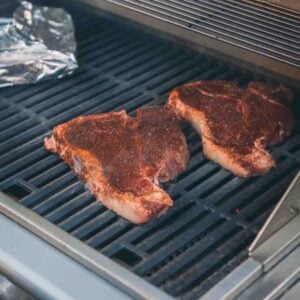
Ingredients
For the steaks:
- 2 steaks about 1 pound each and 1 inch thick
- kosher salt
To Serve:
- Freshly ground black pepper
- Compound butter
Instructions
Prep the steaks:
- Prep your steaks by seasoning them with salt and letting them sit at room temperature for at least 20 minutes.
Prep the grill:
- Meanwhile, prep your gas grill for indirect heat. Turn all of the burners on and allow the grill to preheat to 450 for searing steaks.
- Clean and oil your grill grates.
- When ready to cook, turn off 2 of the 3 burners to create a 2 zones of heat, a cool zone and hot zone.
Grill the steaks:
- When ready to grill, place the steaks on the grill grates at a 45 degree angle.
- Sear the steaks for 2 minutes.
- Rotate the steaks 90 degrees and sear for another 2 minutes.
- Flip the steaks and cook for another 2 minutes, or to your desired internal temperature.
- Depending on the thickness of the steak, you may need to let the steak continue to cook on the cool side of the grill.
Rest and serve:
- With long tongs, remove the steaks from the grill and transfer them to a clean cutting board.
- Add a dollop of compound butter and tent with foil to let the steaks rest 5 to 10 minutes.
- To serve, slice the grilled steak from the bone, if needed, and into thin strips against the grain.
- Sprinkle with a dash of salt and black pepper and serve with your desired steak sauce.
Notes
For thicker steaks, check out the reverse sear method.
Nutrition
Bookmark this recipe now!
FAQs
Many oils can be used, but common ones are canola oil, vegetable oil, or grapeseed oil for their high smoke point and neutral flavor.
A sirloin, ribeye, or filet are the best cuts to place on the grill. They are packed with flavor, cook quickly, and will give you a delicious meal.
For 1-inch steaks, grill your steak for about three to five minutes on high heat until it is golden brown and slightly charred, then turn the steaks over and continue to grill for 2-4 minutes for medium-rare, 4-6 minutes for medium, or 8-10 minutes for medium-well or until the internal temperature of the steak has reached your desired temp with an instant read thermometer.
Fire Up Your Grill! If you want to create a perfectly cooked steak, get your gas grill up to high heat between 450-550 degrees F. and you’ll be on your way to deliciousness!
When you’re searing steaks over direct heat, keep a close eye on them with the lid open. However, once you move it to indirect heat, you can then close the lid and let the smoke and ambient heat work its magic. It’s the perfect way to get the most flavor out of your steak!
Flare-ups can be scary, but rest assured, they can easily be avoided. Use long tongs, keep the lid open if grilling hot and fast, watch out for wind, burn the grease away, and clean your grill regularly.
An absolute favorite way to enjoy leftover steak is to eat it cold on a salad. Cold steak mixes well with leafy greens and a tasty vinaigrette.
You can also reheat your steak either on the grill or in the microwave for lunches the next day. Serve them with a side salad, tasty veggies, or on a sandwich.
